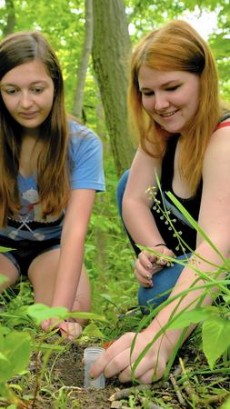“I watch the movie a few times,” Robles said. “Then I improvise on the piano while I’m watching the movie. Then I wrote an entire score of just piano music. Then I added different instruments and tried different things. Once I finished orchestrating it, I’m putting it on sheet music.”
On Oct. 8, the film will be shown at Reid Hall accompanied by Robles’ score performed by the Lake Forest College Orchestra.
Over at the Johnson Science Center, students Glenn Ohman and Amalie Ausland-Bjerkely are researching the affect emerald ash borers have on the biodiversity of forests.
“Our big question is what should forest managers do with their dead ash trees,” said Assistant Professor of Biology Lynn Westly. “Are ash trees significantly changing the composition of the forests? In most forest preserves the dead trees are left standing. When you do that, are you encouraging invasion by things like buckthorn?”
The three have traveled to wooded areas in Lake County to identify and measure the number of invasive species, moisture under the trees and bird activity in dead ash trees.
They are collaborating with professors at the University of Illinois – Chicago and the National Forest Service. They plan to write recommendations for the Lake County Forest Preserve and Lake Forest Open Lands on what they should do with their standing ash trees.
Other students ventured far outside of Lake County.
Assistant Professor of Biology Sean Menke and students Ellie Bacon and Cortney Oates traveled to California for 12 days to study the Argentine ant, an invasive species that arrived in the U.S. about a century ago.
“They are financially problematic due to their impact on agriculture,” Menke said. “And a pest in your house.”
Back at the lab, Menke shows off a collection of Argentine ants pinned to a board like a butterfly collection.
“I really enjoyed the field work,” said Bacon, although she said it was difficult to deal with walking through a species of invasive grass.
“The top parts get stuck on everything you are wearing and scratch your legs,” Bacon said. “We had to duct tape our socks to prevent it getting in.”
Oates, a chemistry major, said she chose this research in an effort to step outside her comfort zone.
“It was more seeing if I liked field work or lab work,” Oates said, concluding that “I hate field work.”
Oates and Bacon have analyzed their data and created a PowerPoint presentation.
Over in the basement of the library, sophomore Sophie Mucciaccio is working with Anne Thomason, college archivist and librarian for special collections, to analyze letters between architects Edward Bennett and Daniel Burnham.
“I knew absolutely nothing about Bennett or Burnham,” said Mucciaccio.
Nine weeks later, she can recite Bennett’s history from memory.
Bennett, originally from England, met Burnham while working in New York. They designed and built parks in Chicago then worked on the Plan of San Francisco with Burnham supplying many of the ideas, but Bennett doing most of the day-to-day work.
Bennett then moved to Chicago and the two collaborated on the Plan of Chicago, which they completed in 1909.
“Chicago was growing very quickly and the infrastructure was not adequate to handle future growth,” Mucciaccio said. “The Plan of Chicago was to do lots of widening and lengthening and rerouting of certain roadways, create new bridges and a lot of new parks. Grant Park and the waterfront were all part of the Plan of Chicago.”
Mucciaccio and Thomason are also converting the letters to a digital format, which will soon be accessible to the public through the school’s website.
On July 22, students in the Richter program will present their work from 9 a.m. to 4 p.m. at Hotchkiss Hall. The public is welcome to attend.
Twitter: @reporterdude
